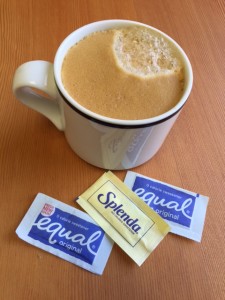 On the way to Ikea the other day, I was consumed by an overwhelming sense of hunger. Big stores do this to me — something about the thought of walking all those aisles.
On the way to Ikea the other day, I was consumed by an overwhelming sense of hunger. Big stores do this to me — something about the thought of walking all those aisles.
Unfortunately, my tasty lunch was tucked away back at clinic. And reports of horsemeat-laden Ikea Swedish meatballs were still fresh in my mind, ruling out a store-based snack. (News flash: Ikea just now offering vegetarian meatballs!)
So I reached into my purse and pulled out my daughter’s pack of sugar-free Bubble Yum. The blast of guilt-free sugary sweetness was surprising and, well… delicious.
Back at the office and halfway through the build-out of my desk, I began having some pains through my midsection. I assumed it was due to the contorting positions required of Ikea projects, so I changed into my more accommodating running pants — no improvement.
I complained to one of my office mates, who happens to be a psychologist. She suggested the pain was due to my age. (Now that’s therapy.)
By the time I picked my daughter up at the school bus, I was convinced I had a full-blown case of appendicitis or ruptured ovarian cyst. But then I remembered: the Bubble Yum! I was reacting to the artificial sweetener.
Abdominal pain is one of the more common medical issues we encounter here at Baskin Clinic. Our first step in evaluation is always a dietary history, which is usually quite revealing. Some of the many offending substances we all commonly consume include:
- Sugar substitutes such as Splenda, Equal, Sweet & Low, and others
- Caffeine
- Beer and carbonated drinks
- Foods containing short chain carbohydrates called FODMAPs (fermentable oligo-, di-, and monosaccharides and polyols). FODMAPs are poorly absorbed and can result in bloating and gas production. Examples of FODMAPS include broccoli, cauliflower, mushrooms, cabbage, and beans.
- Anti-inflammatories, from the lowly aspirin to name-brand non-steroidals like Celebrex.
Still other possibilities include air swallowing and onset of lactose intolerance. As a girl from the dairy Midwest (Ohio), I thought I was immune from the latter. But yes, I am lactose intolerant since my thirties.
Examples of sugar substitutes are sorbitol, xylitol, and mannitol. These “fake sugars” are not easily digested (which is why they are noncaloric – we don’t absorb them). But as we have previously discussed, noncaloric sweeteners still have deleterious effects on metabolism. Additionally, as these compounds pass through the gut they start to ferment (translation: form gas) and draw water into the colon. For some people this heralds symptoms of bloating and diarrhea.
I often see patients for chronic gas and distention who have no idea that sugar substitutes may be contributing to their condition (and that with cessation, those symptoms can quickly improve). Recently one patient had complete resolution of her condition by switching from Equal to sugar in her morning coffee.
For some people use of simethicone (found in Gas-X, Mylanta Gas, Phazyme) can help break up gas bubbles, but our experience is that only about fifty percent of patients find these medications helpful. The best medicine, really, is avoidance.
My story ends well. I made a quick trip to the grocery store for a strawberry ice cream bar for my daughter and a box of Gas-X for me (we both opened our purchases before paying). In about an hour, I was good as new.
But should you desire to read more about the dark underbelly of artificial sweetener-induced gastric distress, check out the reviews for sugar-free gummy bears on Amazon. The stories are as humorous as they are distressing — it’s like reading the script for an entire episode of Curb Your Enthusiasm.
So please read the ingredient labels for those candies and drinks – sugarless sweeteners are hidden everywhere! Your stomach will thank you.
